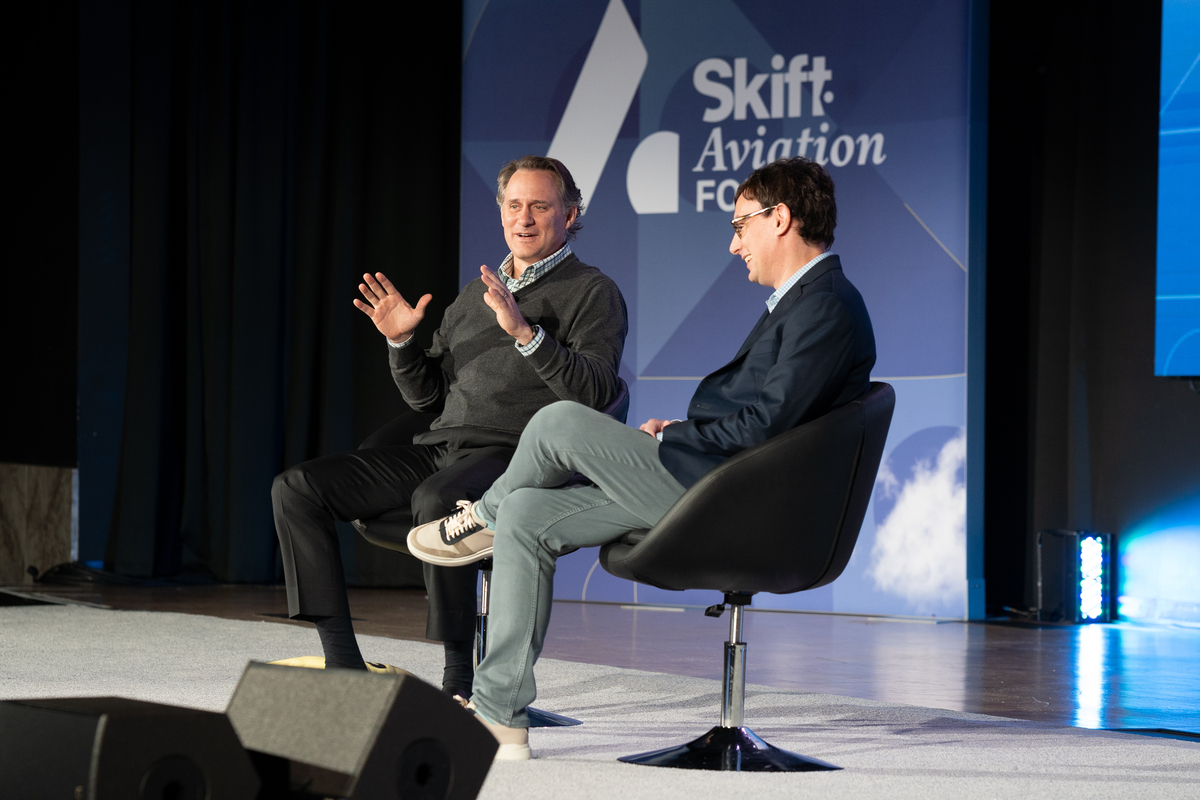Full Video: Sun Country Airlines CEO at Skift Aviation Forum 2022

Skift Take
Sun Country Airlines CEO Jude Bricker believes it’s premature to draw firm conclusions about the emergence of new travel patterns seven months into the travel industry’s recovery. But Bricker said at the recent Skift Aviation Forum that surging airfares are changing travelers’ behaviors, including driving more consumers to fly on Tuesdays instead of the weekend.
Bricker also touched on the company’s cargo operations, its decision to expand flights out of its Minneapolis hub and why he doesn’t believe pilot shortages are a major concern for Sun Country.
Watch the full video of Bricker’s interview with Skift Editor-at-Large Brian Sumers below. You can also read the transcript below.
Interview Transcript
Brian Sumers: Hi, Jude.
Jude Bricker: Hey, Brian.
Sumers: I have been looking forward to this for a long time. First, a note for all of you, we’re taking audience questions on the app, and I want you all to know that Jude is one of the only CEOs I’ve ever met who answers almost every question honestly.
Bricker: Wow.
Sumers: So he is worth the time to ask a question to.
Bricker: That’s not fair to my industry.
Sumers: Well there’s a lot of spin that happens in this industry. All right, so I get to ask the questions first.
Bricker: Still trying to …
Sumers: I got a question for you. We’ll give some background in a second. But if anybody listened to Scott Kirby on the United Airlines earnings call a few weeks ago, he said that the ultra low-cost model is a Ponzi scheme.
Bricker: I love you lead with that.
Sumers: He said that if companies like yours can’t grow every year, they’re not going to be able to outrun their costs and they’re not going to be low costs anymore. Are you running a Ponzi scheme, sir?
Bricker: I like your question on the back of your intro, which said that about airline CEOs in general. Scott’s always had the best model that you could possibly have in airlines when he was with America West and American and now United. It’s always the perfect one. I think that Scott has disparaged the [ultra low-cost] space for many years, not just with the pilot situation we’re in now. Look, a couple things — one is, no, we’re not. I think what he’s getting at, which is I think really interesting is that, do [ultra low-cost carriers] depend on growth in order to maintain their cost structure.
In the case of Sun Country, we don’t. I mean, we’re a mature maintenance organization. We buy used airplanes. Our cost structure, keeping it low isn’t dependent on adding new airplanes and new pilots and keeping juniorization. The company’s been around for 40 years. So, no, in that regard. I think what also might be interesting is the demand for [ultra low-cost carriers] is changing with all the things that we’ve talked about like de-peaking a demand, mobile workforce, tight pilot situation. And no, I mean, fares are still the primary decision point for most travelers as they buy airfares. So, there’s a place for [ultra low-cost carriers]. It’s a rapid growth segment of the U.S. Aviation market. It just hasn’t changed over.
Sumers: So that was Scott Kirby being Scott Kirby? We love him.
Bricker: Yeah.
Sumers: Yeah.
Bricker: I’m a huge fan, by the way.
Sumers: All right, I wanted to ask you about what you’re talking about peak and off peak.
Bricker: Yeah.
Sumers: You worked at Allegiant before Sun Country. You’ve always been at airlines that have essentially parked airplanes on Tuesdays and Wednesdays when the demand wasn’t there. You worked in an industry that had certain patterns of demands. And now, although there are a lot of people, including Robert Isom from American this morning who say, the old patterns of demand are gone and people are traveling seven days a week. What do you think?
Bricker: I got a lot to say on that. The first thing I’d say is we’re seven months into the recovery, so everybody should just pump the brakes a little bit on making forever judgments off seven months of data. I’m not naive to think that Zoom and [Microsoft] Teams haven’t fundamentally changed the way we work. That’s true. But also what’s happened in that seven month period, as was talked about several times up here today, is that we don’t have enough seats in the market so fares are really high. High fares change people’s behavior.
I believe many people are traveling on Tuesday, today, because they can’t afford to travel on the weekend. Peak fare are still really high compared to off peak fares. As a percentage, we’ve seen off peak increase more than they have in peak, but on a dollar basis, it’s relatively the same. As I plan the airline going forward, I’m not reconfiguring all my airplanes so that I can add more high product seats to take advantage of the bleisure customer. That’s not in the plans. I’m not planning on a gigantic September 2023. I think what we’re going to see is a reversion to the mean with the caveat that we do have a lot more mobile workforce and that will blur the edges that were relatively, sternly defined in the past.
Also, I don’t think it’s fair to characterize my experience, my strategy as an airline executive as not flying Tuesdays. The focus is about demand-driven dispatch, and that’s about being very finite and specific about dispatching an airplane on the best use of that airplane at that moment in time. And in the context of that, I think it’s a superior model. There’s a couple ways to make money in airlines. You can be the low-cost provider, that’s Ryan and Wizz and Indigo India, and certainly Frontier and Spirit. You can be gigantic or you can do something no one else can do and that really is our secret sauce here is demand-driven dispatch. Try to find opportunities across the calendar that we can get this really high returns, and that’s what we’ve been able to demonstrate.
Sumers: So one thing that you’ve done to try to reduce the peak and off-peak periods is, you have a deal with Amazon to fly packages. You do a lot of charter stuff.
Bricker: Yeah.
Sumers: Has there ever been any part of you looking at the demand patterns right now say, oh no, I really should have had these airplanes available for passenger service. Are you happy with the charter and the-
Bricker: Yeah, absolutely. No, passenger service is the best thing that we have going for us right now, scheduled passenger service. And I would love to be able to be sort of absolutely dynamic and change cargo, and particularly, our track programs, which are long-term contracts. But I think on the whole, we intend to outperform the industry sort in all environments, so I need to make long term bets on cargo and track programs, which comprise … So I have 54 airplanes, 17 of them, about a third, are devoted to these long-term contract programs which provide good margins, stable economics, and pass through economics, importantly, so fuel and all that stuff is passed through. And so we’re making the long-term bet.
When we did the cargo program in 2019, it was to address the fundamental strategic challenge that Sun Country has had in our 40-year existence, which is how do I be really big when things are really good without breaking the bank when things are bad? So think of a spectrum of 365 days of operating opportunities. There’s like the obvious stuff that everybody makes money on in all environments, starting with the Sunday after Thanksgiving, holiday travel, just March weekends. There’s like 100 awesome days in every airline’s calendar, there’s 100 awesome days. And then there’s 100 really crappy ones, and that’s like starting with the Tuesdays in September. And then the middle is where we adjust capacity up or down based on inputs like fares, fuel, etc.
And so the challenge we had had is our awesome days were really, really good, and to add capacity on those days, we couldn’t sink our off-peak days even worse. And so, cargo is the solution to that because it’s absolutely flat and that’s why we went into it. It just so turned out, we entered into a deal with Amazon in late [2019] and started flying just after Covid hit, so it was better than we thought it was going to be, for sure, just because of when we started it up. But the fundamental reason of going into it is still very valuable to us today and it just helps de-peak the schedule. And it allows me to be… We have the lowest chasm in the industry. It depends on how you measures somewhat, but we do a lot of charter flying into [fixed-based operators]. We do a lot of high cost flying by choice, but I’d say scheduled service in and out of Minneapolis, we’re as low cost as anybody in the industry. And we do that with a July schedule that’s three times bigger as a September schedule. Yeah, that’s the secret sauce right there.
Sumers: So if coming into Covid, there were 100 days a year that were crappy for an airline.
Bricker: Yeah.
Sumers: You talked about not making any decisions based on seven months of data, but do you think they’re going to be fewer than 100 crappy days?
Bricker: No. No. It’s still crappy. The fuel prices. So let me answer it like this. We’re seeing markets have a longer season than they have ever had, and that’s really valuable to us. But it’s very specific markets, which gives me some doubt that this is a permanent change. So for example, Minneapolis to big cities. Minneapolis to big city for us at Sun Country is mostly about [visiting friends and relatives] traffic in the summertime. Memorial Day to Labor Day, Minneapolis to Boston, New York, D.C. Metro, Dallas Metro, Houston, Indianapolis, Cincinnati, [Los Angeles], San Francisco, Portland, [Seattle-Tacoma], all those markets had always been really good for us, and the traffic tended to end around Labor Day. This year, those markets were really great into September.
I think primarily the reason that that happened was the resurgence in business customers brought the fares up and we were able to continue to fly under those fares profitably for longer. I don’t think you’re going to see though that, that particular dynamic be permanent, is my view. I mean, the resurgence in business customers has been great, but ultimately, the Deltas and Uniteds and American will be able to grow into that demand and they’re going to make September crappy again.
Sumers: All right. I wanted to ask you a little bit about the Minneapolis hub. You made a big announcement about new routes this week. I think they were more than 10. Just three of them, JFK, Charlotte, and Detroit. Do anybody know what those have in common? John Kirby, you know what those have in common? No. No, this is a big Delta hub, as John said. Why make the decision to grow in Minneapolis where you have a hub carrier that can really cause some damage to you if it wants to?
Bricker: First of all, Brian, thanks for asking the question, and I hope this Delta out there that I can’t call. But I can tell you right now, we’re trying to turn Minneapolis into a two airline market. If you pay with your own money, you fly Sun Country. If you fly on a corporate contract, you fly Delta. Delta’s about 70 percent of the seats. If you have a business contract, you’re probably flying Delta. The transition of Sun Country, when I got there, a big part of that was, remove the competitive nature of Sun Country to Delta. Delta will win those contract. Delta has the breadth. Delta’s a great airline. They have great operations and a great product.
But those markets are currently served either exclusively by Delta or with Delta with a carrier that’s focused on bringing people into Minneapolis. And so I think there’s an opportunity to be additive to those markets focused on [visiting friends and relatives] customers or customers paying with their own money and therefore care what they pay, to be able to provide a travel alternative. All of those markets that we announced are seasonal. We’re very focused on the leisure traveler that tends to fly those kind of markets between Memorial Day [and] Labor Day. Those seats will be redeployed into leisure markets in the wintertime, that are more traditional into Florida, Mexico, Caribbean, Southern California, desert destinations like Vegas and Phoenix. But Minnesotans don’t have a real good option for nonstop travel to many of these destinations at low fare.
And so, our market announcement yesterday doesn’t change the philosophy that I have towards Delta and have always had, that there’s a really valuable place in my community for Delta Airlines. I want them to be hugely successful. I want Minneapolis to stay a Delta hub because it brings in Fortune 500 companies. I want to see downtown Minneapolis thrive again. Delta’s a big part of that. But I also want to bring access to low-cost travel for more Minnesotans and that’s simply what we’re doing.
Sumers: Have you seen a competitive response yet?
Bricker: Not yet.
Sumers: Has there been a market that you’ve gone into since you were at Sun Country for Minneapolis, where Delta has said, “Nope, you’re not going to do that?”
Bricker: Actually they’ve said that, no, is the short answer, but they have not … There’s been only a handful of markets where they have not responded in some way. Usually, the response is benign and that means we see you, we’re going to add Saturday only. We’re not going to change our fare structure, stuff like that. And that I think is a rational response because really focusing on [origin and destination] traffic in a hub with your fare structure can be very dilutive to your flow traffic. Everything that they’ve done has been absolutely rational. Everything we’ve done has been absolutely rational. And that has manifests itself in my market share since I got there, has expanded on an origin basis in Minneapolis to the mid 20s. They’ve also picked up market share in Minneapolis while we’ve been expanding, and that’s to the detriment of the network carriers, which they take on directly in the low-cost space, which I take on directly.
Sumers: It’s a fun little game, these airlines play-
Bricker: Isn’t it fun?
Sumers: … about sandboxes and who can play where.
Bricker: In the capacity constraint environment, everybody has to be a lot more rational. There’s not a lot of turf battles going on in the U.S. right now.
Sumers: I know when you got to Sun Country, I feel like you tried to open some new markets, get some flying out of Minneapolis, try some new things. Dallas was one of those places. But it does seem now when you expand, it’s Minneapolis. So why have you gone back to the basics there?
Bricker: So it’s not an indictment of non-Minneapolis opportunities, it’s just Minneapolis is the best thing we have going for us right now for two reasons. One is, it requires very little capital investment to launch a new Minneapolis market in the form of advertising or anything like that. We have a very strong brand. I have about a million and a quarter. There’s only about four and a half million Minnesotans in the Twin Cities, and I [have] about a million and quarter households participate in my loyalty program, which is basically, effectively full saturation. So, it’s really easy to launch a new market from an awareness perspective.
And the second point is, it’s the most efficient thing that I can do with my crews. So when you think about growing an airline in this environment and my biggest constraint right now is pilot hours, the most flying I can get from a pilot duty hour is a Minneapolis out and back and that’s why it’s the focus. Dallas will always be a big part for us between Memorial Day and Labor Day, this goes back to the Champion Air days at Sun Country. I don’t know, [1980s] and [1990s]. We fly Mexico, Caribbean, Vegas, Minneapolis from here. And in the summertime, it’s a huge part of our network. In fact, in July, the market we fly with the most [available seat miles] is Dallas/Cancun and that’s not going to change. It’s just the growth that we see, the best opportunity, really the best return on a pilot duty hour for us is a Minneapolis flight. I think that’s probably going to be the case for another year.
Sumers: Great. All right. You were quoted recently saying that Sun Country might look at wide body aircraft.
Bricker: Oh my gosh.
Sumers: Might want to return to Europe. Yeah.
Bricker: So first of all, I wish you were there.
Sumers: What, were you joking?
Bricker: No, I wasn’t joking. The question was though from someone like you, I’ve noticed the reporter said, that your new contract has wide body rates. “Why would you do that?” And I said, “Well, I think that maybe there’s some opportunity in the distant future.” That was the way I answered it, and then the headline of the article out coming that interview was Sun Country Launches Wide, something like that.
Anyway, here’s the point. What we do today with the 737 NG, I think works with the 767 8330, older wide body, particularly because wide body rates are coming out of Covid. There’s a lot of wide bodies in the market that were getting really cheap. If we had a sponsorship into the program from the likes of DHL or Amazon that got us into the cargo side of it, and then we could capitalize on that with a peaky demand driven scheduled service operation, I think it would be absolutely viable.
There’s a near 0 percent chance we do anything like that in the next three years. Mostly because, there’s so much opportunity for growth. Every pilot I upgrade to captain today, I add 60 hours a month of flying. And if I were to add 330 or 767s today, I’d have to pull back a cadre to train and do ditching and all these things, and it would set my growth back substantially. So there’s the opportunity cost, which is a new input because we’ve mostly been operating, in my career, in a situation of surplus pilots, the opportunity cost of a new fleet type, other than the Max, which is relatively efficient for me as an NG operator, a new fleet type is very, very high and almost impossible to overcome.
Sumers: That’s not the most exciting answer that I wanted.
Bricker: Sorry.
Sumers: I was ready for low-cost flights to Europe.
Bricker: Yeah, it’ll probably come from a European operator in this environment, I’m afraid, like Norse Atlantic.
Sumers: You’ve always been known for your obsession with getting the best deal-
Bricker: Obsession.
Sumers: … on used airplanes.
Bricker: I mean, I certainly hope-
Sumers: We’ve heard today that the market is very, very tight. Are you guys able to source airplanes with your growth?
Bricker: … Absolutely. Yeah, we don’t have any problems. But look, first of all, I hope everybody in my seat is really focused on getting the best deal on airplanes. Our issue is that we want to be low cost at low utilization at the same time, because I think the trade off of an increased unit revenue from a lower utilization is really powerful. Again, I want to be different from everybody else. We don’t want to have a lookalike airline because it’s challenging for me to justify the existence. We need to be different, and our difference is being able to source these large market traffic origination markets with low utilization and do it with low cost.
So, it’s natural then to focus on used airplanes. Your question is probably more about what the used market looks like. And today, what we’re seeing is crisis all over the world that’s providing lots of used airplanes. I mean, there’s a laundry list of NG operators that I could give you, I won’t, of airlines that I think are going to provide my future fleet, and we’re in negotiations with the owners of those airplanes or the airlines themselves constantly.
We grew the fleet. We went into Covid with 32 airplanes. In February, we’re going to be a 54 airplane [company]. So my fleet is about 70 percent bigger. My operations as judged by block hours, because we added cargo, are only going to be next year versus [2019], about 45 percent bigger. So the best opportunity I have is just flying the planes I have a little bit more, and that’s just recovery of utilization. It’s not adding utilization. And in this environment, it won’t be that revenue dilutive either.
So the point is, we don’t need a lot of additional airplanes. Our most recent deals have come from the Norwegian bankruptcy, and we’re taking on five airplanes from those. We see a steady supply of lease returns. I’d certainly agree with Steve’s comments earlier about airlines are extending leases a lot more commonly than they had because of delays in new deliveries, but that doesn’t relieve the problems of some of the Southeast Airline, Asia carriers, the [aircraft, crew, maintenance, insurance] operators that are really struggling in this environment. I think there’s going to be plenty of capacity.
Sumers: Even Maury Gallagher at Allegiant finally bought new airplanes. You could do it.
Bricker: Yeah, I could do it, and I’ve done it in the past. I remind you. I did buy new airplanes at Allegiant, too. I think that there’s a challenge with just getting a big used fleet. At some point, the complexity of used airplanes is a limiting factor. On a percentage growth basis, you’re going to have to continue to add more incremental units every year to keep that percentage growth going. I can add about a plane a month, full bore. I don’t think I’m going to be able to add more than that as we get bigger. So it will become a constraint in growth, but I think we can double with the used fleet. I think we can get a hundred airplanes. I think all that’s going to be fine with the 737 NG 800 is the core of what we do. I think we’re many years away from making that jump. And by the way, by then, there’s going to be used maxes so it’ll be a bigger marketplace.
Sumers: So the joke is, it’s not a joke necessarily. I understand why they want it, but pilots want to fly the newest, shiniest, biggest airplanes. It’s a tight pilot market now. Are you able to attract the pilots that you need?
Bricker: Yeah, so I thought it was interesting. There was a comment earlier, a couple sessions ago about just a training gap. That is my situation distilled. We’re getting plenty of pilots. I started hiring before everybody because we had the cargo market going. We did a new pilot deal. The top of scale into contract rate for my captains is higher than Delta’s on the 737. Obviously, they’re going to leap frog us, I think, soon. That seems like. So I mean, we pay for that.
When I’m talking to potential new hire pilots, it’s about quality of life, rapidity of growth so that you can get promoted very rapidly. The guy talking up here before was talking about eight years to captain upgrade. I got captains that work for me for 12 months and they’re moving to the left seat, so that’s the kind of stuff that I can offer and I think it used to be, I think if you were going to go work at Sun Country 15, 20 years ago, you’d be really worried about, can I make a career here?
Sun Country’s not going anywhere. We have the best. The last 12 months we made widest margins. We’re public now with a strong balance sheet. So I think we’ve got a lot to offer the pilot community that’s manifesting itself, and all my new hire classes are full. In fact, if you wanted to work for us as a pilot, I probably couldn’t put you into a class for the next four months.
Our issue today is about captain upgrades, which is a voluntary process, and it’s just about being able to hold a seniority level that you can hold a quality schedule. And so it’s interesting to me as being in this airline industry for a long time, pay is way up there now. And the difference between an [first officer] pay and a captain pay is still 70 percent. I mean, it’s a much more lucrative job, but quality of life has become much more centric to decision making, not just for pilots, but sort of across all my employee groups. It’s really interesting that, that’s become such a focus. And a junior captain, you’re junior again, and so, the mindset of our pilots is really about getting better schedules and there’s a lot we can do, a lot we got going on to make it better, but mostly it’s growth.
Sumers: Thank you, Jude. I’m afraid we did not get any audience questions.
Bricker: Oh, no questions? Does that mean that we don’t have time or does that mean that there wasn’t any?
Sumers: That means there wasn’t any.
Bricker: Oh.
Sumers: I know.
Bricker: That’s kind of-
Sumers: Disappointing, right?
Bricker: … Yeah, that is a bummer.
Sumers: Thank you so much for the time.
Bricker: Nice to see you, Brian.
Sumers: It’s been great.
Bricker: Yeah.





